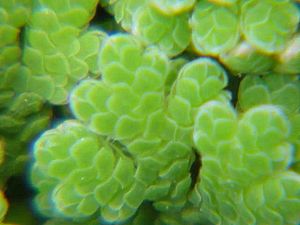Water fern facts for kids
Quick facts for kids Water fern |
|
|---|---|
 |
|
| Zoomed picture of Azolla filiculoides | |
| Conservation status | |
| Scientific classification | |
| Genus: |
Azolla
|
| Species: |
filiculoides
|
| Synonyms | |
|
|
Azolla filiculoides is a tiny plant often called the water fern. It's a type of fern that floats on water. You can find it in warm parts of the Americas, Asia, and Australia.
This fern grows very fast. It can quickly cover the surface of a lake in just a few months. Each plant is small, about 1 to 2 centimeters wide. It's usually green, but its edges can turn pink, orange, or red. As it grows, it branches out and breaks into smaller pieces.
The water fern doesn't like cold weather. In cooler places, it mostly dies in winter. But it survives using special buds that stay underwater. Inside its leaves, the water fern has a tiny helper: a type of bacteria called Nostoc azollae. This bacteria helps the fern "fix" nitrogen from the air. This means it turns nitrogen gas into a form the fern can use to grow. It's like the bacteria gives the fern its own special fertilizer!
Scientists have found old Azolla filiculoides plants as fossils. Some of these fossils are from the last ice age in Europe. This shows the plant has been around for a very long time.
Azolla filiculoides was one of the first two fern species to have its full genetic map (called a reference genome) published.
Contents
How to Identify the Water Fern
It can be tricky to tell Azolla filiculoides apart from a similar plant called Azolla cristata. The best way is to look closely at the tiny hairs on the top of its leaves. These hairs are called trichomes.
- In Azolla filiculoides, these trichomes are made of just one cell.
- In Azolla cristata, they are made of two cells.
These tiny hairs help the plant float and resist water.
How People Use and Grow Water Ferns
People have moved Azolla filiculoides to many parts of the world, like western Europe, southern Africa, tropical Asia, and New Zealand. They grow it because of its amazing ability to fix nitrogen.
Farmers often use it to help crops grow better, especially rice grown in water. The nitrogen it provides acts like a natural fertilizer. Sometimes, people even remove the fern from lakes and use it as "green manure" to enrich soil.
However, because it grows so fast, Azolla filiculoides can sometimes become an invasive species. This means it spreads too much and can take over natural areas, sometimes harming local plants and animals.
Where the Water Fern Lives
This water fern is originally from the Americas, Asia, and Australia. It has also been introduced to other places. For example, it was brought to Clandeboye Lake in County Down, Ireland.
Gallery
-
Azolla filiculoides (pink-tinged) growing together with Lemna minor duckweed





